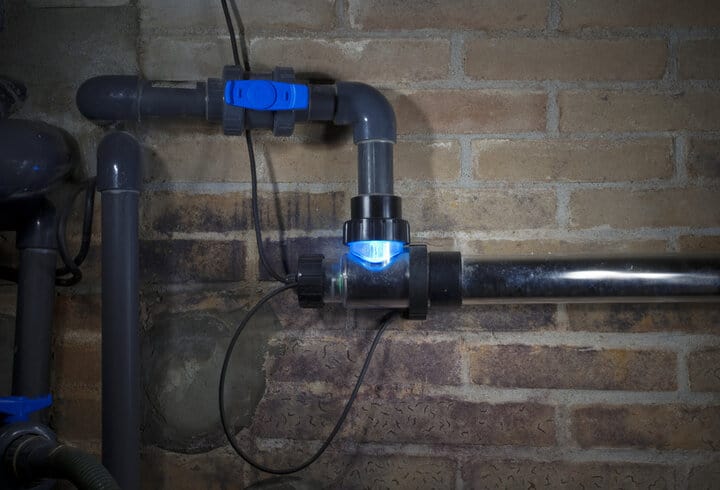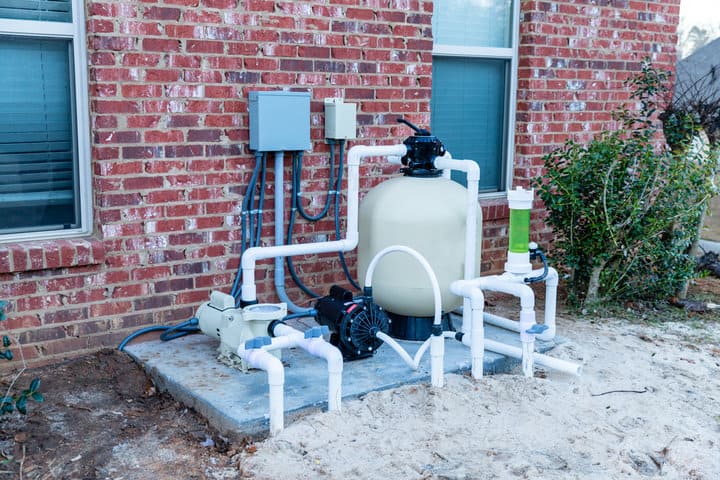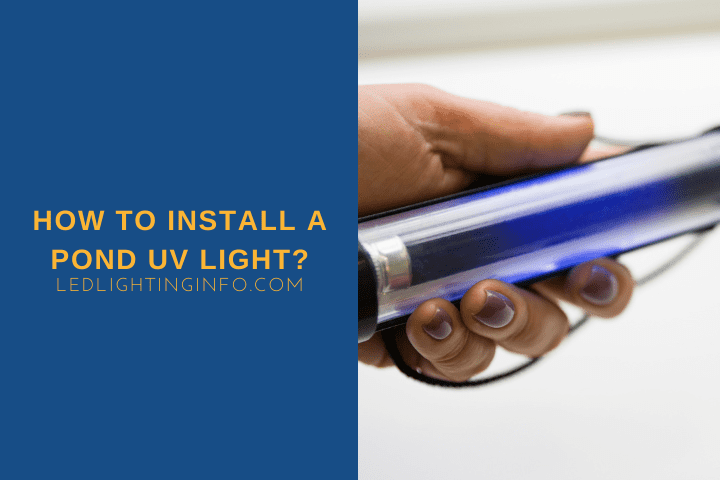It can be frustrating if you’ve spent a long time setting up a pond in your garden – getting the lighting perfect, the accessories, and the overall design of the space – and then the water starts to turn murky.
You want your pond to look clear to appreciate the wildlife or see your lighting properly.
Thankfully, if you install a UV light in your pond, you can help to control those algae and microorganisms that can cause issues.
But how do you install one?
A pond’s UV filter light must be installed in a dry location. They’re waterproof but can’t be flooded – the best location is secured on top of a filter or attached to a post near the pond. They work best when placed after the main pond filter, as the light runs less risk of damage and can work more effectively.
In this guide, I’ll explain:
- How to setup your UV light in your pond
- Choosing the right size of light
- The location of your UV pond light
How To Setup UV Light In The Pond

Installing a pond light is a relatively simple process. It has an inlet and an outlet, and then on one end, the area where you’ll screw in the bulb.
It must also be powered and come with a standard plug attached.
Here’s what you need to do:
- Turn off your existing pump system
- Run a pipe or hose from your mechanical filter to the inlet valve on the UV light, using the included plastic nuts to hold it in place
- Run a pipe or hose from the outlet back into your pond – you can run it straight into the pond or into a water feature such as a fountain
- Install the bulb in the ballast of the pump, and then push that into place. It may be threaded to be screwed in – check the specifics of the pump you buy
- Run the power cable for the UV light to a plug socket. If using an outdoor socket, make sure it is properly waterproofed.
Once it is ready, power the UV light to check that it works. There will be a small hole in the filter, which the bulb shines out of.
Don’t look directly into this! If you can see it from an angle, that’s enough.
If it is working, turn the pump and filter system back on and check there are no leaks.
Here are a couple of key safety tips:
- Never look directly into the UV bulb. It can damage your eyes
- Never handle the bulb with your bare hands, even when off. Your natural skin oils can cause the bulb to overheat later
- The bulb is delicate – take your time and don’t force anything if it feels like it isn’t sliding into place correctly
What Size UV Light Do I Need?

The size of the UV light you need depends on your pond size and whether you want to clarify the pond or sterilize it.
And then, you have a few other factors to consider depending on your choice of the latter.
As a rule of thumb, you need 10 watts of UV power per 1000 gallons of water if you want to clarify your pond water – make it look clear.
And you need 30 watts of UV power per 1000 gallons to thoroughly sterilize it – removing viruses and pathogens.
There are other factors involved. Algae can grow more effectively if your pond:
- Has a lot of plants or fish (which provide nutrients for algae)
- Is exposed to a lot of sunlight and warmth, which promotes algae growth
If either is true, you may prefer a sterilizer light over a clarifier to ensure it works more effectively.
But if your pond is empty and is in a more shaded area, a clarifier-level UV light will be effective enough and – crucially – much less expensive.
That price matters since you’ll need to replace the bulb annually to keep it working. It’s not a one-off price difference.
Where Should I Locate UV Pond Light?

There are two things you need to consider when it comes to the placement of your UV pond light – specifically, where you’re going to keep it safe and whether you’re installing it before or after the mechanical filter for your pond.
Regarding safety, the only things you need to consider are making sure the light isn’t submerged in the water, that you don’t run it so far from the filter that the pump struggles, or that you have extensive pipework or hose that you need to hide.
You’ll want to keep it as close to the filter as possible but in a dry location.
If your mechanical filter is situated enough above the water level, you could mount the UV light on top of it.
Otherwise, you’ll want to secure it from the pond’s bank to another structure.
You can insert a wooden stake into the ground, provided it’s big enough to support the weight of your light and attach it to that.
It’s okay to be exposed to rain, but you must keep it off the ground so it can’t be fully submerged in a puddle of water.
The bigger question is whether to place it before or after the mechanical filter. The mechanical filter is what removes the bigger debris from your pond water.
Generally, most people place it after the filter because:
- The water is clearer of debris, so the UV light can work more effectively – it is cleaning the water, and not the floating items in the water
- Any small rocks or other hard debris will be captured by the filter and won’t damage the quartz sleeve around the UV light
- Some of the thicker sludge will be captured by the mechanical filter, reducing the maintenance needed for the UV light (which needs the sleeve cleaning regularly to work at its best)
There is one benefit to having the mechanical filter after the UV light.
The filter can capture dead algae and microorganisms from the UV pond light.
If the UV light runs straight back into the pond, that dead matter can collect at the bottom of the pond, where it can act as food for more algae to grow.
It’s more of an issue if you have a rocky pond bottom – if the pond bottom is smooth, the dead matter is more likely to get sucked up into the filter again and collected.
Overall, weighing up both pros, people generally prefer UV light after the filter.
Final Words
While it seems like a tricky prospect, installing a UV light isn’t too tough.
You’ll want to ensure it’s appropriately mounted in a safe, non-submerged location and that it’s not so far from the pump and filter that the water isn’t flushed through it enough.
Do that – and make sure you choose a suitable bulb wattage – and you can look forward to crystal-clear pond water.
Have you had any issues with murky water or with installing a UV clarifier or sterilizer?

